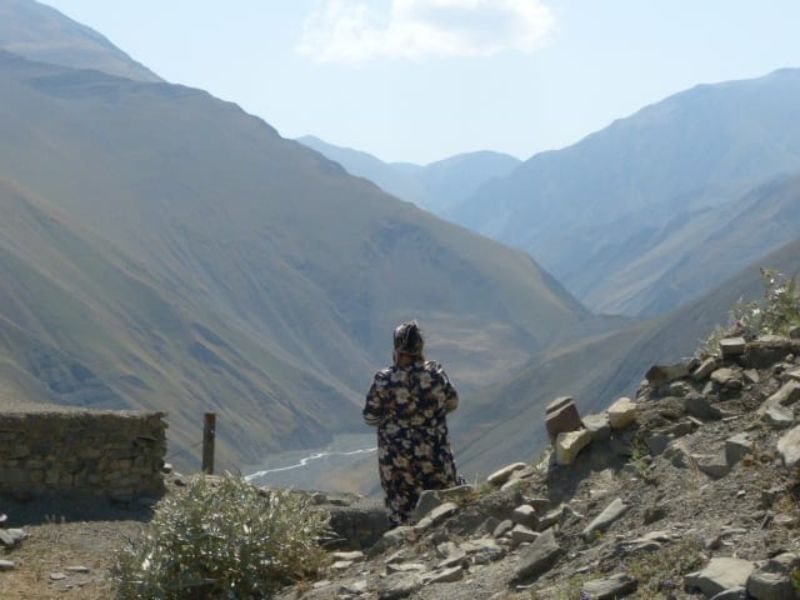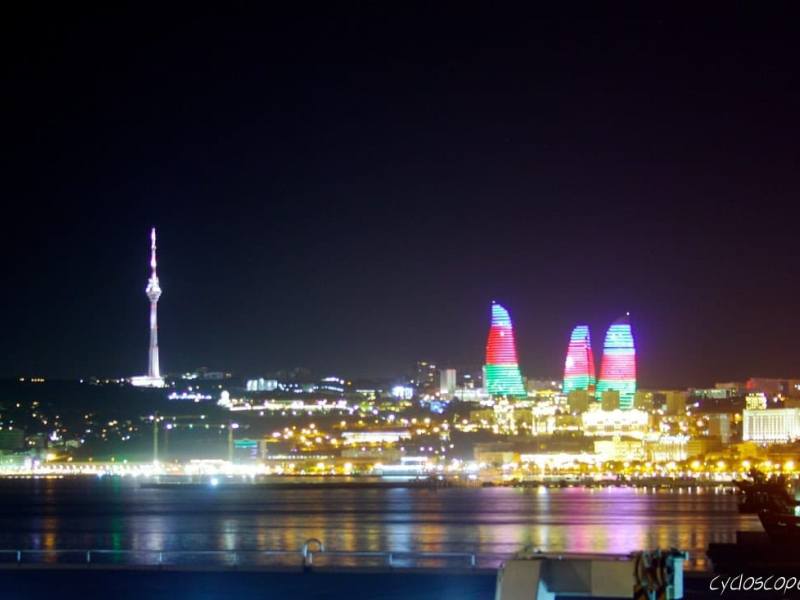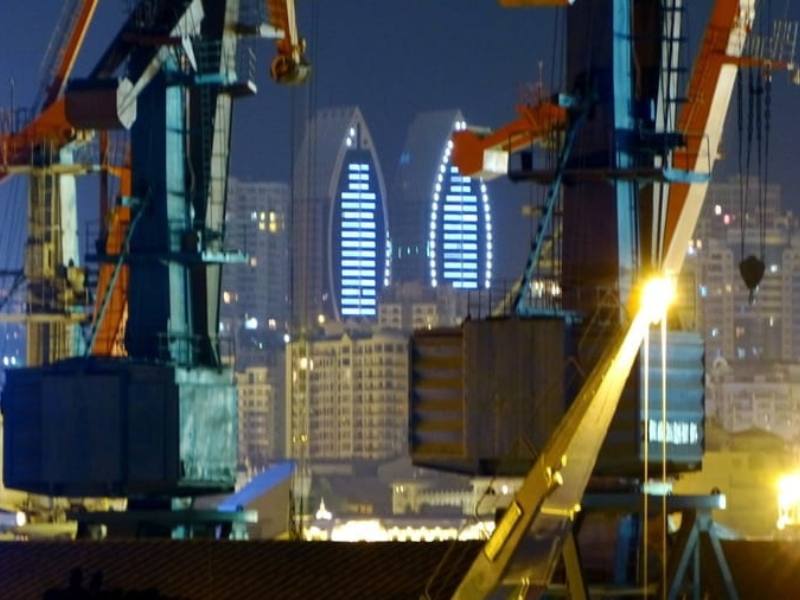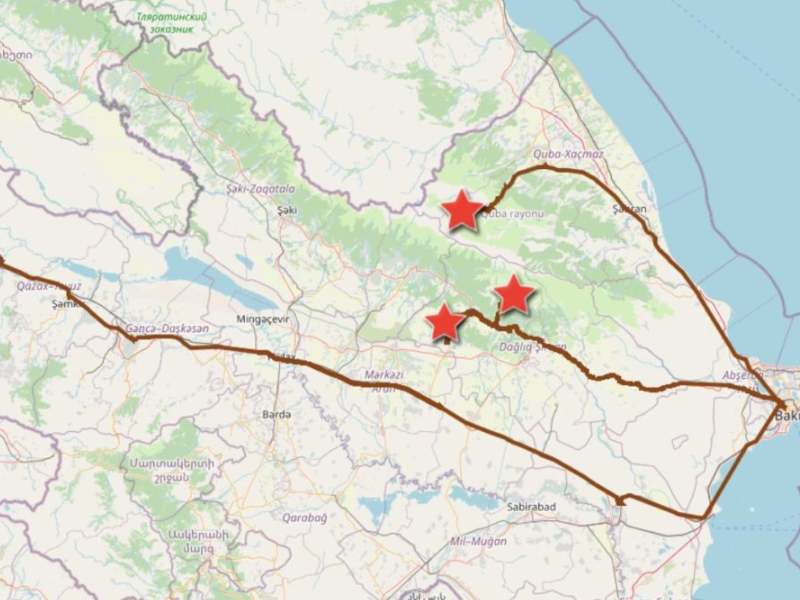Last Updated on 31 May 2024 by Cycloscope

Bicycle Touring in Azerbaijan – Not only desert, rich cultural heritage, ancient religions, ancient Silk Road cities, and warm hospitality
Azerbaijan is not a prime tourist destination, but many bicycle travelers end up crossing it on their way east, following the so-called Silk Road. Even if in most people’s minds Azerbaijan is just petrol and desert, the arid plains are mostly in the central region.
There are also the mountains of the Greater Caucasus range, with Mount Bazardüzü, the highest peak in Azerbaijan, standing at 4,466 meters, and Xinaliq, a picturesque and ancient mountain village located at about 2,300 meters (7,546 feet), it is one of the highest and most remote villages in the country. Xinaliq is renowned for its stunning natural beauty, traditional stone houses, and rich cultural heritage.
And there is also the Caspian Coastline, where the capital Baku, with its futuristic buildings and historic sites, is located, the world-famous Yanar Dagh, meaning “Burning Mountain”; a natural gas fire that blazes continuously on a hillside. Fueled by subterranean natural gas, the flames can reach up to three meters high and have been burning for centuries.
Fire is always present, especially during the extreme summer heat, when we have cycled in Azerbaijan. The ancient Zoroastrians revered fire as a symbol of purity and the divine. This reverence is evident in several places around Azerbaijan, including Yanar Dagh.
What not to miss during a bikepacking adventure in Azerbaijan
- Baku
- Yanar Dagh
- Mud Vulcanoes
- Lahic
- Xianaliq
- Ivanovka Kolkoz
The Territory of Azerbaijan

Azerbaijan is a Caucasian State, enclosed between the Greater Caucasus to the north and the Lesser Caucasus to the South. What’s in the middle is a flat desert-like steppe, where all the major cities are, and that’s where we rode during our bicycle trip in Azerbaijan, although we also visited some parts of the Greater Caucasus, namely Lahic, Ivanovka, and Kinaliq. The central lowlands are pretty dry, not easy to find clean water, and even harder to find any shade, if you look hard anyway, there are both.
The Culture of Azerbaijan – Things to Know Before You Cycle There

Among the Former Soviet Republics, Azerbaijan is one of those that didn’t benefit from the sexual equality ideology pushed by the Soviet Union, the country is still tied to a very machistic culture, thus making it, not the most enjoyable place to travel for women, especially when traveling solo.
Some may blame this on the Muslim religion, but we don’t believe so. Although a huge majority of Azeri people would call themselves Muslims, you’ll encounter very few mosques in the whole country, while is not uncommon to see people drinking vodka, even during Ramadan.
It’s extremely rare to see women driving here, they mostly sit in the back of the cars, you’ll never see any woman drinking or smoking, except maybe for a few ethnic Russians in Baku. Cycling especially is considered inconvenient for girls, the saddle is seen as an auto-erotic stimulator (the same was true in some parts of Europe until maybe WWII).
Be careful when drinking water given by locals, we got sick because of that, Azerbaijan is indeed the only country where we used our MSR water filter.
Azeri people are generally friendly but sometimes kind of weird when it comes to manners with Western ladies, more than once they asked me the price of one night with Elena, to stay calm (I almost lost my temper honestly).
One more very important thing to know: never mention you like Armenia or Armenians. The dictatorship of Azerbaijan did a great job brainwashing its citizens, making them believe Armenia is their natural enemy, if you don’t know why do some research about the Nagorno Karabakh ongoing struggle.
Try not to get involved in political discussions about this topic, especially if you support the Armenian cause, it can seriously cause you trouble. Having an Armenian stamp on your passport can make each police check painfully slow while having visited the Nagorno Karabakh area will make it impossible to enter Azerbaijan until you don’t get a new passport.
Wild Camping in Azerbaijan
Camping in the wilderness of Azerbaijan, despite all the bad we mentioned so far, is very easy and safe. The country is sparsely populated, camping is not usual but not illegal, or at least nobody bothered us while we were free camping. We cycled for about a month in Azerbaijan and camped or being hosted every night, without any problem. We haven’t slept in hotels so can’t really say much about that.
Visa for Azerbaijan

We applied for the Azerbaijan Visa in Tbilisi, it was an easy process but we had to wait for almost a week. And it can be problematic if you have an Armenian stamp on your passport. You can easily get the Azerbaijan Visa online, a solution that I suggest if you do not have time to wait in Tbilisi or elsewhere.
Your passport must be valid for at least 6 months beyond your intended stay, and if you wish to stay longer than your visa permits, you must apply for an extension before your visa expires.
Cycling to Baku
If you cross from Rustavi, in Georgia, you have 500 km to Baku, mostly flat, with a little up and down but nothing challenging. It is important to know the first ATM is 40 km from the border. Eventually, we cross the village of Qazakh/Agstafa, where there is a cash machine. After this pleasant town, I think about twenty kilometers, we reach another small river and take the dirt road that runs along.
We are headed to Baku, where we’ll get on the ship to Kazakhstan (now departing from another port in the South, Alat) We were here in July, avoid it if you can, the temperature under the sun was around 50 C and I actually suffered a sort of sunstroke on this road. Everyone greets us, even more than in Georgia, so we forget the terrible heat for a few seconds at a time.
The best seasons to visit Azerbaijan are spring (April to June) and autumn (September to November) for mild weather, and blooming or harvesting scenery.
Huge photos of the former president (Heydar Aliyev the father of the actual dictator Ilham Aliyev) who died in 2003, loom over the citizens, always accompanied by a few words that should be a quote. Along the way, we often saw these photos, placed in out-of-place gardens in the desert, always with someone cutting the grass around, or watering the trees that otherwise would never survive there.
We arrive in Ganja, the third largest city in the Country, the temperature under the sun is always about 46°. After ten kilometers we arrive at the Kura river. Near the stairs leading to the river, there’s a little police guardhouse. There comes a policeman who tells us where we can swim, we leave the bikes there and go down. This will be one of the few chances you have to take a bath along this road
Desert to the right, desert to the left. Along the way, some watermelons and melons sellers trying to shelter themselves from the sun in the small shade of a few trees, more and more rare.
Then comes the Caspian Sea, it is at our right but we barely see it, there are often long walls between the road and the shore. Probably the private property of a few oligarchs.
Baku – Chess, Oil and Mud Volcanoes

We arrive in Baku, the capital city of Azerbaijan, the core of the dictatorship, the temple of the oligarchs. With a population of 2,374,000, this is the only big city in Azerbaijan, if you really want to feel the mood of the country that’s where you should be, but be aware (and I’m sorry to say that), it is not a great mood. We are hosted by a guy who is following us, he wanted to show us the real Azerbaijan.
We took the subway and headed for a walk in the city center. After the main square, we head towards the Caspian seafront, which we could also call the oil pond front. the Caspian Sea is black, literally. That is, it’s oil, and it smells a lot. To see the fish swim there eating crumbs and oil is very impressive. Doesn’t really inspire a fish meal in Baku. Petrol is cheap (60 cents per liter), and people are wealthier than in the countryside, or at least so it seems.
In those days, the European Olympic Games were about to start. Our host told us that to prevent any kind of action that could draw attention to the lack of democracy, freedom, and the other many political issues of Azerbaijan, the government arrested everybody they could guess to be connected with independent political groups.
After our walk along the shore, we head to Baku’s old town. As far as we understood, until the discovery of oil in the nineteenth century (the first drilling of the world was made here), Baku was a village in the desert, with a few thousand inhabitants; and in fact, this old town is very small. It seems that after the earthquake of the year 2000, UNESCO wanted to remove Baku Old Town from its list, due to the lack of restructuring, but it has been readmitted after a controversial restoration.
Baku’s skyline is a surreal mix of ultra-modern buildings and ancient architecture. The futuristic Flame Towers, which light up the night with LED displays, stand in stark contrast to the medieval walls of the Old City and the Maiden Tower.
Outside the city center, Soviet-style buildings house the majority of the inhabitants. During the day the gardens are full of men playing chess or backgammon. Chess holds a special place in Azerbaijan’s cultural and sporting landscape. Known for producing world-class players, including Teimour Radjabov, Shakhriyar Mamedyarov, and Vugar Gashimov. Chess in Azerbaijan is more than just a game; it’s a celebrated aspect of the nation’s identity, fostering community and intellectual growth.
Just outside Baku, you can find one of the world’s largest concentrations of mud volcanoes. These bubbling, gurgling mounds of mud are a bizarre natural phenomenon and a must-see if you are looking for something out of the ordinary. And the world-famous Yanar Dagh, meaning “Burning Mountain”; a natural gas fire that blazes continuously on a hillside
Khinalug – the highest village in Europe

Khinalug sometimes spelled Xianliq, is probably the most interesting place to visit in Azerbaijan. With an elevation of 2350msl is the highest settlement in Europe, if you want to consider Azerbaijan in Europe.
The houses are made of riverstone, with flat roofs. Until just a few years ago, before the road was completed in 2006, there were no other materials available, and the village could be reached only on horseback.
Xinaliq is part of the ancient Albanian tribes, so they also have their own language, and even though the villagers are allegedly Muslim, many still practice the ancestral Zoroastrian cult.
Many houses are fenced by walls made of tiles of dried cow dung and straw. They serve as fuel to warm in the cold winter. The view from the top of the country is truly amazing. And it is amazing to think that for thousands of years, the people of this village have been doing well, just using what this remote piece of land, surrounded by impassable mountains, gave them. The river provides water and stones for the houses. Cows and sheep food, clothes, and heating. Nothing to cultivate.
There are also many old cemeteries, no archaeologist has dug here so they still remain a mystery. Some tombstones are just stones planted in the ground, others have inscriptions in ancient Turkish or in other tongues. The oldest one might be Neolithic.
At the end of the town starts a dirt road, the entrance to the Şahdağ National Park, where a beautiful trek starts. The landscape around is stunning and absolutely unmissable.
Read our full article about Khinalug, the highest village in Europe
Lahic – the Copper Kingdom

Lahic is a pearl of the Caucasus, a really must-visit place if you’re traveling in Azerbaijan. Its history dates back at least 2000 years, here people speak a different language, spoken only in this village.
Lahic was for centuries the place of excellence for copper crafts all over the world, kings and sultans from the region and far beyond prided themselves on artistic items manufactured here. Lahic is also famous for its peculiar architecture, a mix of wood and stone drywalls that makes the houses here completely anti-seismic.
The inhabitants of Lahic are indeed descendants of one of the 26 Albanian Tribes of the Caucasus and have preserved ancient traditions and their peculiar language due to the remote location of the village.
Visiting Lahic is certainly one of the best things to do in Azerbaijan, while here you can visit the many copper craft shops, and the small museum, and enjoy the prayer call resonating from the mosque in the valley.
To reach Lahic you can take the bus from Baku to Ismailli and then to Lahic by private driver.
Read our full article about Lahic: Copper Wood and stone
Ivanovka, the last Kolkhoz

The small town of Ivanovka is the last kolkhoz in Azerbaijan and possibly in the whole former Soviet Union. A kolkhoz is a form of collective farming, where all the villagers are workers and share the profit of their work in equal parts.
Ivanovka is set in the foothills of northern Caucasus, the landscape is mainly made of gently rolling hills filled with bucolic fields. The houses are very colorful and there’s a quiet atmosphere of peace. But the most interesting thing about Ivanovka, that makes this place a must-visit point of interest, and it is turning it into one of the main tourist attractions in Azerbaijan is for sure its history.
Here in Ivanovka, this collective farming is still practiced by the local ethnic groups of the Molokans, a sect of ethnic Russians deported at the time of the Tsar for their refusal to adhere to the Orthodox rite. It’s weird to see that those keeping on with communism are the more religious in the country.
80% of the population is composed of Molokan, there are some “mixed” marriages but they are not well received by the community. Some people don’t even know a word of Azerbaijani, even if they have lived here for a few centuries.
Agriculture and farming are still practiced collectively. The kolkhoz is divided into departments, each of which focuses on a particular sector (tractors, vines, animals). At the end of the year, they sell products on the market (but no longer with the Soviet Union’s rules) and share the profits.
Read our full article about Ivanovka, the last Kolkhoz
Our Bike Tour in Azerbaijan – Map



